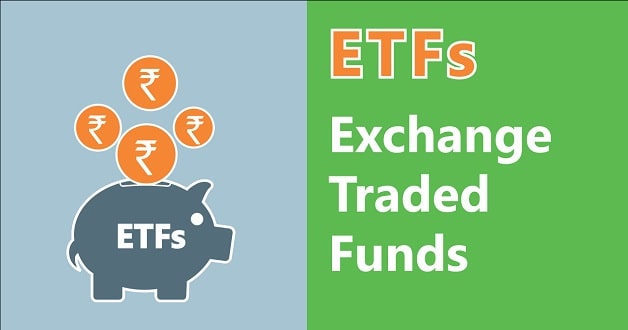Exchange Traded Funds or ETFs are passive mutual fund schemes which track the price of a market index or the market price of a commodity. ETFs tracking a market benchmark index like Sensex, Nifty etc invest in a basket of securities constituting the index. Like index ETFs, commodity ETFs invest in physical commodities like Gold, Silver etc.
Characteristics of ETFs

- Each security in an ETF has the same weight as it has in the index. For example, if a stock has 5% weight in the Nifty, the same stock will also have 5% weight in a Nifty ETF.
- Like mutual funds, ETFs are also managed by professional fund managers of Asset Management Companies (AMCs).
- Unlike actively managed mutual fund schemes, ETFs do not target to beat the index, instead they simply try to track the index returns as closely as possible.
- ETFs are listed on stock exchanges and are traded just like shares of listed companies. ETFs are bought or sold in stock exchanges on the basis of the current market price (bid / offer prices) at the time of the day.
- Unlike actively managed mutual fund schemes which are bought or sold at mutual fund NAVs, the market price of ETF units can be higher or lower than the Net Asset Value (NAV) of the ETFs.
- You can subscribe to units of ETFs at the time NFO, just like mutual funds. The AMC will allot units to you based on the face value of the ETF at the time of NFO.
- After the NFO period, you will have to buy or sell ETF units on the stock exchange unless you are transacting in lot sizes or creation units as specified by the AMC in the Scheme Information Document (SID).
- AMCs appoint market makers to ensure liquidity of their ETFs in the stock exchange. The market makers are specialist stock brokers. They set the bid / offer prices and often act as counter-parties in a buy / sell transaction.
- If you are transacting (buying / selling) in lot sizes or creation units, as specified by the AMC, you can buy / sell ETF units directly with AMC at the applicable NAVs. The lot size (number of units) of creation units set by the AMC is usually quite large; larger than the average transaction size of a retail mutual fund
- You need to have Demat and trading account with a stock-broker to invest / trade in ETFs.
- The Total Expense Ratio (TER) of ETFs is much lower than the TERs of actively managed mutual fund schemes.
- Market prices of commodity ETFs reflect the market price of the physical commodity. For example, the price of a unit of Gold ETF represents the value of a certain weight of pure 24 carat Gold.
- Commodity ETFs are much more cost efficient investments compared to the physical commodity (e.g. Gold, Silver etc) because they do not involve storage costs for the physical commodity and there is no risk of impurities (e.g. impurities in Gold jewellery).
Conclusion
ETFs are becoming increasingly popular in India. ETFs as a category is now the largest category of mutual funds in India (source: AMFI, May 2022). In this article we have discussed about the characteristics of Exchange traded funds. Consult with your financial advisors, if you want to know about it and invest in ETF.
Santosh Kumar is a Professional SEO and Blogger, With the help of this blog he is trying to share top 10 lists, facts, entertainment news from India and all around the world.
